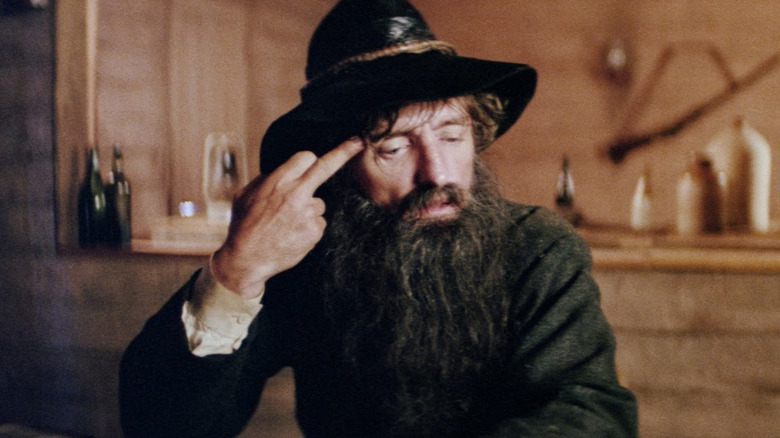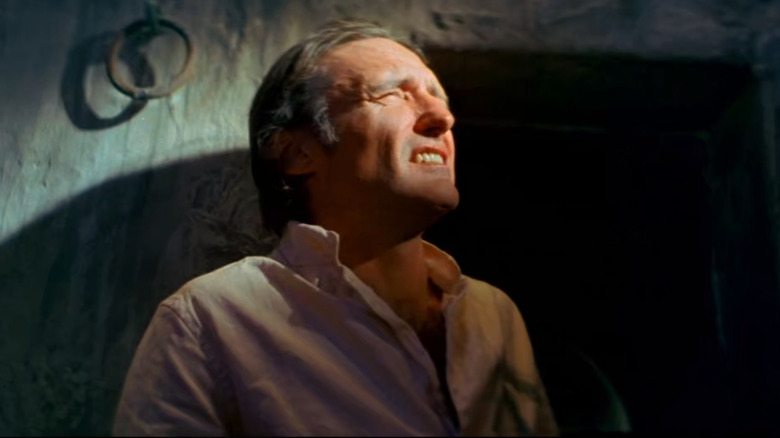Actor Dennis Hopper was the kind of artist myths are made from. He was an incredibly talented performer with a larger-than-life personality that frequently got him into trouble. His reckless behavior and intense drug abuse could make him incredibly difficult to work with, and he even tried to get Marlon Brando to fist-fight him after a misunderstanding before the filming of “Apocalypse Now,” leading to the two being separated on set at all times. In the mid-1970s, however, he behaved so badly while filming a movie in Australia that he was not only declared dead on his feet and banned from driving a car in the state of Victoria ever again, but he was also kicked right on out of the country.
That movie was “Mad Dog Morgan,” a disturbing 1976 outback Western based on the true life misdeeds of bushranger and outlaw Dan Morgan (whom Hopper played in the film). The Ozploitation, aka Australian exploitation, flick was directed by prolific French-Australian director Phillipe Mora, who would go on to direct the second and third “Howling” films. It’s a nasty piece of work featuring a scene where Morgan is brutally sexually assaulted in prison, as well as another where a man’s head explodes from a gunshot wound at close range. Though “Mad Dog Morgan” is mostly now an interesting footnote in Australian cinema history, Hopper’s wild method acting has since become the stuff of legend.
Hopper embraced method acting and got arrested on his first day in Australia
Hopper used the Stanislavsky Method, frequently known as “Method acting,” to bring authenticity to his roles. In the case of “Mad Dog Morgan,” that meant leaning into the real Dan Morgan’s purported binge drinking. In the documentary “Not Quite Hollywood: The Wild, Untold Story of Ozploitation!,” Jeremy Thomas, a producer on “Mad Dog Morgan,” revealed that Hopper was “arrested and put in jail within a night of him arriving in Sydney. He was already in fighting down at the pubs.” Associate producer Richard Brennan also alleged that Hopper was doing a lot of cocaine, which wasn’t exactly historically accurate.
Despite Hopper being an absolute wild card and Aboriginal co-star David Gulpilil going on walkabout for four days in the middle of shooting to ask the birds and trees about Hopper, who said he was “crazy,” the movie’s crew somehow managed to finish filming “Mad Dog Morgan.” Just after shooting the final scene, however, Hopper went off the handle for the last time on Australian soil. According to Hopper himself in “Not Quite Hollywood,” he decided to go visit the grave of the real Dan Morgan immediately after filming his death scene. He then “proceeded to down a bottle of 151-proof rum” and decided to “destroy the cemetery.” He apparently then got into a car, announced he had formerly been a racecar driver, and sped off, still dressed as Mad Dog.
Eventually, Hopper was apprehended by Australian police, though not before doing some damage. He was dragged before a judge as quickly as possible, who declared that he was legally dead based upon his blood alcohol content before banning him from even riding in a car in Victoria ever again. The judge then sent him straight to the airport to leave the land down under. When you get kicked out of the same country that produced the brain-melting bizarreness of George Miller’s “Mad Max” movies, that’s honestly pretty impressive.
Mad Dog Morgan’s legacy as a dark Western
“Mad Dog Morgan” is a bit of an oddity, with some serious high points (Hopper is really giving it his all, plus there are some great shots of the Australian wilds) and just as many lows. When the movie was screened for executives in Australia, Mora said that many of them hated the film and thought it would go nowhere. Despite this, it became the first Australian film to ever get a U.S. distribution deal at Cannes Film Festival.
Mora also credited the film’s reviews in New York, Los Angeles, and London for helping him get a job directing a film for United Artists. Audience reviews on Rotten Tomatoes, on the other hand, are far less kind. Morgan’s sexual assault at the hands of several other inmates is pretty graphic and likely to upset many viewers, while the movie’s actual plot (or lack thereof) is rather nonsensical. Still, if nothing else, “Mad Dog Morgan” gave us one of the wildest stories in cinema history — one involving Dennis Hopper, a bottle of 151 rum, and a whole lot of mayhem.
This wouldn’t be the last time Hopper caused problems on set, of course. Years later, he was even fired from his role in Aussie director Peter Weir’s “The Truman Show,” where he was replaced by Ed Harris. As for “Mad Dog Morgan,” the film doesn’t have the infamy of something like Hopper’s claim to fame, “Easy Rider,” but it’s also simply a lesser film by comparison. (“Easy Rider,” it’s worth mentioning, had plenty of its own controversies involving Hopper, who feuded with most of the cast and was even sued by Rip Torn.) Sometimes, the making of a movie is even more interesting than the movie itself. Just look at “Hearts of Darkness,” the documentary about the making of “Apocalypse Now.”

